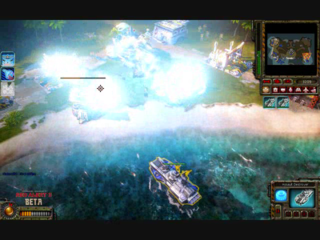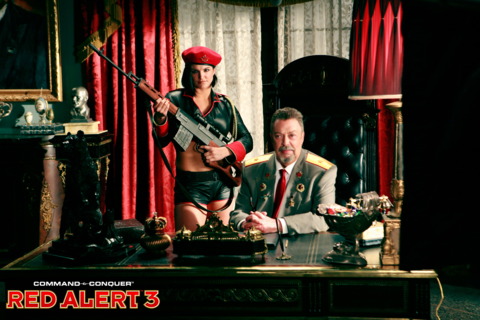
The story in Red Alert gets a big reset in the form of some time machine chicanery. The opening shows you the Soviet leaders, on the verge of defeat as the Allies roll onto Russian soil. Thinking fast, the Russians employ the use of an experimental time machine, go back into time before all of the events of the Red Alert series (which, if you remember, were also caused by a time machine), and eliminate Albert Einstein. With no Einstein, there's no nuclear weaponry, and when the Russians go back to the future, they find that the Soviet forces are no longer on the verge of crumbling. Instead, the Allied forces are down and out. But the feeling of victory doesn't last long, as a new threat emerges as a direct result of the timeline-tampering and the Japanese forces rumble onto the scene to create a three-way conflict.
Three factions and a big-time focus on naval combat are the cornerstones of Red Alert 3. The faction differences are meaningful enough to require you to employ different strategies, but similar enough to where you don't immediately feel like one side has an edge. Each faction builds differently, with the Allies retaining the most C&C-like build system of placing completed structures on the battlefield. The Soviets build structures on the map as soon as they start construction, leaving their structures open to attack while being built. Meanwhile, the Empire of the Rising Sun's technologically advanced forces spit out small core vehicles from their construction yard, which then must be driven to a location and unfurled. There are also differences in how base expansion works, as well as the way the tech trees work and how they distribute to different parts of your base.
The campaign mode takes you through all three factions. Though you can take them on in any order, the game most-logically progresses from the Soviets, then the Allies, and wrapping up with the Empire. Like previous C&C games, you'll find bonus objectives to complete, and the story is told via full-motion video sequences that set up each mission. You'll also get a lot of video during the missions in a window that doesn't block your view of the action. This gives the missions a lot of personality and keeps you engaged in the Red Alert world at all times. All of the FMV and interaction between characters really makes the campaign a treat to see, as you'll encounter a lot of great moments on all sides.

The large naval component to Red Alert 3 means that you'll see a lot of water-filled levels. Also, every one of the game's multiplayer maps has some sort of water on it. The levels with more water mean you'll have to figure out ways to expand your base onto different islands or use troop transports to ferry around your non-amphibious units. You can also build most of your base at sea, with only the structures devoted to deploying ground units locked to land. This changes a lot of the strategy commonly found in real-time strategy games and really forces you to rethink the best ways to attack. While Red Alert 3 certainly isn't the first RTS to fight at sea, it certainly takes the role of sea combat further than most.
While there's a lot of differences around the edges of Red Alert 3's campaign and unit design, at its core, this is still based on the classic C&C blueprints. You'll build bases, then build barracks and armor. You'll build commando units and sneak them in to destroy bases. You'll build engineers to capture enemy structures. But you probably won't build gigantic forces and slowly build your base to completion before you even think about attacking. It's a fast-moving game, and pumping out small forces of multifunctional units and sending them off to fight seems to be key here, rather than simply entrenching and building up enough units to stomp around the map. As such, expect to see enemies heading your way pretty frequently, too.
Another thing you'll have to constantly consider as you play RA3 is the special abilities of your units. While each one has its core strengths (which are helpfully identified by a series of tooltips you can get by hovering over the build menus), some of them can convert to perform different tasks. Units like the Empire's Mecha Tengu quite literally transform from a two-legged mech that can handle itself against ground-based units to a jet that can take on any airborne invaders. Or there's the Soviets' Apocalypse Tank, which has a secondary mode that fires magnetic harpoons that drag enemy units closer, where they'll be torn up by the tank's grinders. This gives you a lot to think about and manage if you want to be as effective as possible with your units. At times, all that management gets to be a bit much. I found myself getting a little overwhelmed when battles got hectic. But as you play more and more, you'll learn when to employ each strategy in a more calm and collected fashion.

It helps that the dialogue is well-written and humorous without going too far. The self-serious tone to everything is absolutely key. There's also a lot of unit dialogue, too. While I'm not going to break down a list of everything you'll hear as you play, I will say that there are plenty of little references spread throughout the game, and hearing an Apocalypse Tank reference Scorpion from Mortal Kombat as it drags a unit in for the kill with its magnetic harpoon is always great for a chuckle. The music is also a great component to the audio, from the driving theme of the main menu to the interactive in-mission music that picks up whenever battles commence.
In addition to cooperative play, you can also set up multiplayer matches both online against humans or offline against the AI. Up to six players can compete on the PC, while the Xbox 360 version can handle four. I had a fine time playing skirmish matches against the AI, but as soon as I got online on the PC version, I felt like I truly knew nothing at all about how to play the game and got absolutely stomped by superior players every single time.
The other big story about the Xbox 360 version is that it's essentially the same experience. The game looks very nice when you blow it up on a big screen TV, and the gamepad controls are surprisingly manageable, though there's quite a learning curve if you want to get good at every little nuance and option. The control isn't that different than the 360 version of Kane's Wrath, but there's another layer of refinement here that makes selecting units, deselecting units, and dealing with all of the special unit abilities and top-secret protocol attacks pretty easy to wrap your head around. I suspect that players who don't already have the mouse-and-keyboard controls memorized will have an easier time getting up to speed on the 360. Most of my time was spent retraining myself on how to accomplish common tasks.
While we're talking about the console version, the Xbox 360 doesn't have any matchmaking for co-op games. You'll have to invite someone manually. While it makes sense, since you'd probably only want to play co-op with someone you trust, it also means you'll need to have a friend get a copy of the game and join you. Perhaps you could attempt to make some co-op friends while playing competitive matches.
Red Alert 3 makes compelling changes to the C&C brand of real-time strategy without abandoning the core of what makes these games tick. If you're a longtime fan, that's great news, though if you don't typically go for strategy games, but are still feeling the attraction of the game's stellar cast and full-motion video, you may find that the thrill of the cutscenes isn't quite enough to keep you moving through the missions.